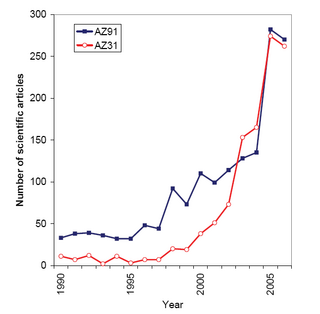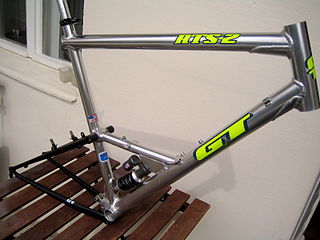In materials science, a metal matrix composite (MMC) is a composite material with fibers or particles dispersed in a metallic matrix, such as copper, aluminum, or steel. The secondary phase is typically a ceramic or another metal. They are typically classified according to the type of reinforcement: short discontinuous fibers (whiskers), continuous fibers, or particulates. There is some overlap between MMCs and cermets, with the latter typically consisting of less than 20% metal by volume. When at least three materials are present, it is called a hybrid composite. MMCs can have much higher strength-to-weight ratios, stiffness, and ductility than traditional materials, so they are often used in demanding applications. MMCs typically have lower thermal and electrical conductivity and poor resistance to radiation, limiting their use in the very harshest environments.

Extrusion is a process used to create objects of a fixed cross-sectional profile by pushing material through a die of the desired cross-section. Its two main advantages over other manufacturing processes are its ability to create very complex cross-sections; and to work materials that are brittle, because the material encounters only compressive and shear stresses. It also creates excellent surface finish and gives considerable freedom of form in the design process.

Maraging steels are steels that are known for possessing superior strength and toughness without losing ductility. Aging refers to the extended heat-treatment process. These steels are a special class of very-low-carbon ultra-high-strength steels that derive their strength not from carbon, but from precipitation of intermetallic compounds. The principal alloying element is 15 to 25 wt% nickel. Secondary alloying elements, which include cobalt, molybdenum and titanium, are added to produce intermetallic precipitates. Original development was carried out on 20 and 25 wt% Ni steels to which small additions of aluminium, titanium, and niobium were made; a rise in the price of cobalt in the late 1970s led to the development of cobalt-free maraging steels.
Titanium alloys are alloys that contain a mixture of titanium and other chemical elements. Such alloys have very high tensile strength and toughness. They are light in weight, have extraordinary corrosion resistance and the ability to withstand extreme temperatures. However, the high cost of both raw materials and processing limit their use to military applications, aircraft, spacecraft, bicycles, medical devices, jewelry, highly stressed components such as connecting rods on expensive sports cars and some premium sports equipment and consumer electronics.

Electroless nickel-phosphorus plating, also referred to as E-nickel, is a chemical process that deposits an even layer of nickel-phosphorus alloy on the surface of a solid substrate, like metal or plastic. The process involves dipping the substrate in a water solution containing nickel salt and a phosphorus-containing reducing agent, usually a hypophosphite salt. It is the most common version of electroless nickel plating and is often referred by that name. A similar process uses a borohydride reducing agent, yielding a nickel-boron coating instead.

Magnesium alloys are mixtures of magnesium with other metals, often aluminium, zinc, manganese, silicon, copper, rare earths and zirconium. Magnesium alloys have a hexagonal lattice structure, which affects the fundamental properties of these alloys. Plastic deformation of the hexagonal lattice is more complicated than in cubic latticed metals like aluminium, copper and steel; therefore, magnesium alloys are typically used as cast alloys, but research of wrought alloys has been more extensive since 2003. Cast magnesium alloys are used for many components of modern automobiles and have been used in some high-performance vehicles; die-cast magnesium is also used for camera bodies and components in lenses.

An aluminium alloy (UK/IUPAC) or aluminum alloy is an alloy in which aluminium (Al) is the predominant metal. The typical alloying elements are copper, magnesium, manganese, silicon, tin, nickel and zinc. There are two principal classifications, namely casting alloys and wrought alloys, both of which are further subdivided into the categories heat-treatable and non-heat-treatable. About 85% of aluminium is used for wrought products, for example rolled plate, foils and extrusions. Cast aluminium alloys yield cost-effective products due to the low melting point, although they generally have lower tensile strengths than wrought alloys. The most important cast aluminium alloy system is Al–Si, where the high levels of silicon (4–13%) contribute to give good casting characteristics. Aluminium alloys are widely used in engineering structures and components where light weight or corrosion resistance is required.
6061 aluminium alloy is a precipitation-hardened aluminium alloy, containing magnesium and silicon as its major alloying elements. Originally called "Alloy 61S", it was developed in 1935. It has good mechanical properties, exhibits good weldability, and is very commonly extruded. It is one of the most common alloys of aluminium for general-purpose use.
2024 aluminium alloy is an aluminium alloy, with copper as the primary alloying element. It is used in applications requiring high strength to weight ratio, as well as good fatigue resistance. It is weldable only through friction welding, and has average machinability. Due to poor corrosion resistance, it is often clad with aluminium or Al-1Zn for protection, although this may reduce the fatigue strength. In older systems of terminology, 2XXX series alloys were known as duralumin, and this alloy was named 24ST.
E-Material, also called E Material, is a metal matrix composite consisting of beryllium matrix with beryllium oxide particles. It has high thermal conductivity, and its thermal expansion can be adjusted to match other materials, e.g. silicon and gallium arsenide chips and various ceramics. It is chiefly used in microelectronics as substrate for power semiconductor devices and high density multi-chip modules, where it aids with removal of waste heat. E-materials have low weight and high strength, making them especially suitable for aerospace technology. Their high elastic modulus is favorable for absorbing vibrations and lowering material fatigue of attached modules and wire bonds.

Friction stir processing (FSP) is a method of changing the properties of a metal through intense, localized plastic deformation. This deformation is produced by forcibly inserting a non-consumable tool into the workpiece, and revolving the tool in a stirring motion as it is pushed laterally through the workpiece. The precursor of this technique, friction stir welding, is used to join multiple pieces of metal without creating the heat affected zone typical of fusion welding.
Al-Ca composite is a high-conductivity, high-strength, lightweight composite consisting of sub-micron-diameter pure calcium metal filaments embedded inside a pure aluminium metal matrix. The material is still in the development phase, but it has potential use as an overhead high-voltage power transmission conductor. It could also be used wherever an exceptionally light, high-strength conductor is needed. Its physical properties make it especially well-suited for DC transmission. Compared with conventional conductors such as aluminium-conductor steel-reinforced cable (ACSR), all aluminium alloy conductors (AAAC), aluminium conductor alloy reinforced (ACAR), aluminium conductor composite reinforced ACCR and ACCC conductor that conduct alternating current well and DC current somewhat less well, Al-Ca conductor is essentially a single uniform material with high DC conductivity, allowing the core strands and the outer strands of a conductor cable to all be the same wire type. This conductor is inherently strong so that there is no need for a strong core to support its own weight as is done in conventional conductors. This eliminates the "bird caging", spooling, and thermal fatigue problems caused by thermal expansion coefficient mismatch between the core and outer strands. The Al-Ca phase interfaces strengthen the composite substantially, but do not have a noticeable effect on restricting the mean free path of electrons, which gives the composite both high strength and high conductivity, a combination that is normally difficult to achieve with both pure metals and alloys. The high strength and light weight could reduce the number of towers needed per kilometer for long distance transmission lines. Since towers and their foundations often account for 50% of a powerline's construction cost, building fewer towers would save a substantial fraction of total construction costs. The high strength also could increase transmission reliability in wind/ice loading situations. The high conductivity has the potential to reduce Ohmic losses.
5154 aluminium alloy is an alloy in the wrought aluminium-magnesium family. As an aluminium-magnesium alloy, it combines moderate-to-high strength with excellent weldability. 5154 aluminium is commonly used in welded structures such as pressure vessels and ships. As a wrought alloy, it can be formed by rolling, extrusion, and forging, but not casting. It can be cold worked to produce tempers with a higher strength but a lower ductility. It is generally not clad.
6005 aluminium alloy is an alloy in the wrought aluminium-magnesium-silicon family. It is closely related, but not identical, to 6005A aluminium alloy. The main difference between the two alloys is that 6005 has a higher minimum composition percentage of aluminium than 6005A. The most common forming method is extrusion. It can also be forged or rolled, but as a wrought alloy it is not used in casting. It is commonly heat treated to produce tempers with a higher strength at the expense of ductility.
6005A aluminium alloy is an alloy in the wrought aluminium-magnesium-silicon family. It is closely related, but not identical, to 6005 aluminium alloy. Between those two alloys, 6005A is more heavily alloyed, but the difference does not make a marked impact on material properties. It can be formed by extrusion, forging or rolling, but as a wrought alloy it is not used in casting. It cannot be work hardened, but is commonly heat treated to produce tempers with a higher strength at the expense of ductility.
6060 aluminium alloy is an alloy in the wrought aluminium-magnesium-silicon family. It is much more closely related to the alloy 6063 than to 6061. The main difference between 6060 and 6063 is that 6063 has a slightly higher magnesium content. It can be formed by extrusion, forging or rolling, but as a wrought alloy it is not used in casting. It cannot be work hardened, but is commonly heat treated to produce tempers with a higher strength but lower ductility.
6105 aluminium alloy is an alloy in the wrought aluminium-magnesium-silicon family. It is one of the least common of the alloys in this series. While most wrought aluminium alloys are covered by multiple standards, 6105 is only dealt with in ASTM B221: Standard Specification for Aluminum and Aluminum-Alloy Extruded Bars, Rods, Wire, Profiles, and Tubes. It is formed by extrusion, and supplied in heat treated form. It can alternately referred to by the UNS designation A96105.
6162 aluminium alloy is an alloy in the wrought aluminium-magnesium-silicon family. It is related to 6262 aluminium alloy in that Aluminum Association designations that only differ in the second digit are variations on the same alloy. It is similar to 6105 aluminium alloy, both in alloy composition and the fact that it is only really used in extrusions. However, as a wrought alloy, it can also be formed by rolling, forging, and similar processes, should the need arise. It is supplied in heat treated form. It can be referred to by the UNS designation A96162, and is covered by the standard ASTM B221: Standard Specification for Aluminum and Aluminum-Alloy Extruded Bars, Rods, Wire, Profiles, and Tubes.
6262 aluminium alloy is an alloy in the wrought aluminium-magnesium-silicon family. It is related to 6162 aluminium alloy, but sees much more widespread use. It is notably distinct from 6162, and most other aluminium alloys, in that it contains lead in its alloy composition. It is typically formed by extrusion, forging, or rolling, but as a wrought alloy it is not used in casting. It can also be clad, but that is not common practice with this alloy. It cannot be work hardened, but is commonly heat treated to produce tempers with a higher strength but lower ductility.
The 6463 aluminium alloy is an aluminium alloy in the wrought aluminium-magnesium-silicon family. It is related to 6063 aluminium alloy, but unlike 6063 it is generally not formed using any processes other than extrusion. It is commonly heat treated to produce tempers with a higher strength but lower ductility. Like 6063, it is often used in architectural applications.





